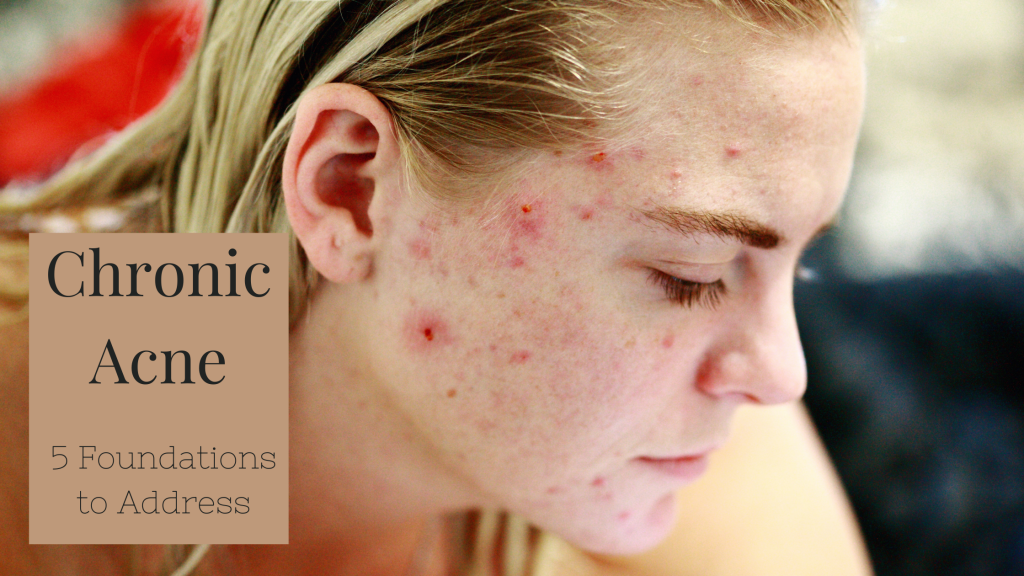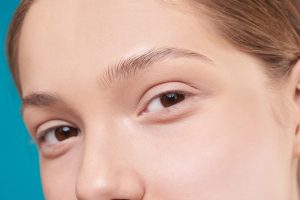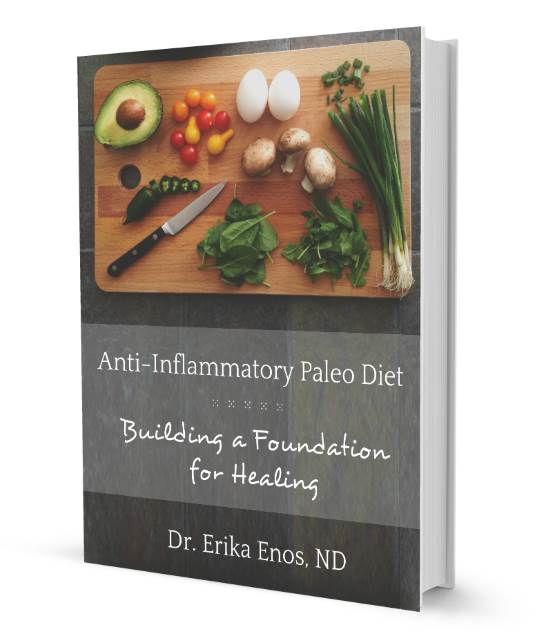
Chronic acne, both cystic and non-cystic, is something I treat often in a wide age range from teenagers to people in their 5th decade of life. Although acne can appear to be topical and cosmetic, it is really much more than that.
As a Naturopathic Doctor, I view what happens on your skin as a reflection of the health of your inner body. This holds true for almost all dermatologic conditions including eczema, atopic dermatitis, psoriasis, acne, hives and many rashes. In fact, the only skin issues I really consider to be unrelated to your inner health is contact dermatitis- rashes caused by skin contact with things like poison ivy, irritating chemicals or allergenic substances like nickel. Truly, even in these cases, I would argue that your inner health may modulate the severity or your response and your ability to bounce back once the irritant has been removed. From this view point, acne needs to be treated from the inside out.
While every patient is unique, there are five top areas that I assess and address in patients looking to heal their acne. In many cases, these five issues are interrelated and at least two but often all five need to be addressed for complete and long lasting skin healing.
- Gut Balance: your microbiome
- Hormones: too little progesterone, poor estrogen clearance, too much testosterone
- Detoxification Pathways: get the toxins out
- Stress handling . . . guess what? This impacts all three of the above contributors
- Diet: removing food sensitivities, adding nourishing foods . . . and guess what? Diet will impact all four of the above contributors!

Let’s dig into these with a little more detail!
Gut Balance:
The health of your gut can impact pretty much any system in your body – and the skin is no exception. It is very common for me to recommend microbiome analysis (usually via stool samples) for patients with acne. While I’ve seen a variety of imbalances in the gut of patients with acne, the most common is fungal overgrowth. Fungal or yeast overgrowth is often called candida but candida is just one type of yeast that may be causing issues. Treatment for yeast involves changes in diets, anti-fungal herbs, probiotics, addressing sugar cravings, and restoring function to the digestive tract. Restoring functions can include first replacing and then restoring digestive juices (stomach acid, digestive enzymes and bile) and correcting issues like constipation. Healing from fungal overgrowth isn’t always a simple or straightforward process. It can often take many months and sometimes a year or more to to fully address.
Hormones:
Hormones are commonly blamed for acne. Honestly though, I rarely find these to be a true root cause. It is common for skin health to fluctuate during menstrual cycles with breakouts most commonly occurring right before menstruation or mid cycle. I frequently find low progesterone, either frankly low or out of the ideal range, high estrogen levels and sometimes high testosterone levels in patients with acne. Being a holistic, root cause-oriented practitioner, I am always asking the questions “why?” In this case: “why are these hormones out of range?”
Progesterone can be low due to stress, poor sleep, lack of minerals, poor diet, food sensitivities and more. Estrogen can be high from environmental toxins that mimic estrogen (xenoestrogens), obesity, a sluggish liver, and imbalanced bacteria in the gut leading to high levels of beta glucuronidase, an enzyme that causes estrogen to recirculate in a toxic form.
Excess testosterone can be caused by adrenal hyperplasia, but more commonly, it is associated with PCOS or polycystic ovarian syndrome. PCOS is a very common diagnosis. It can involve a variety of signs and symptoms including cystic ovaries (although not always despite the name!), irregular menstrual cycles, infertility, excessive body hair growth, obesity, and insulin resistance/blood sugar issues. PCOS is sometimes blamed on genetics, and while genes are no doubt involved, it can be successfully addressed through supporting normal progesterone and estrogen levels, correcting insulin resistance, dietary and lifestyle measures, and other interventions.
Detoxification Pathways:
Your skin, according to Naturopathic perspective, is an emunctory. An emunctory is the term Naturopathic Doctors use for a route of elimination for waste and toxins – both toxins produced inside our bodies as a normal part of day to day functioning and the toxins we take in from outside. For more info on emunctories, check out this post.
Your skin is acting as a healthy emunctory when you sweat. However, when you see skin issues pop up, including acne, it can be an indication that other, more efficient and effective routes of elimination aren’t working as well as they should be. Your lungs, kidneys, liver, bowels, and even your emotions are more efficient routes of elimination than your skin. When the skin is suffering, I think first about liver congestion and secondly about kidneys. We can make a direct connection between the liver, hormones and skin.
Your liver is in charge of chemically altering estrogen before it is removed from your body via your bowels (bringing us back not only to hormone health but gut health as well!). As a Naturopathic Doctor, I don’t rely on blood work alone to determine whether a liver is congested and in need of support. Instead, this is primarily done through symptoms and sometimes a physical exam. An increase in liver enzymes, which is one of the primary ways liver function is assessed on blood work, is a more serious and downstream issue than liver congestion. Liver health can be improved through dietary changes, supporting a healthy gut, removing environmental toxins, minimizing use of pharmaceuticals that are processed through the liver, and through the use of liver nourishing herbs like dandelion and milk thistle, among others.
Stress:
Stress can throw any system in your body off, including your skin! Acne flares are common when stress levels are high. Stress may be directly causing breakouts but more often it is through the impact of stress on hormone levels and gut health. While I do prescribe adaptogenic and nerve calming herbs (or nervines in herbal speak) and supplements for stress, I also work with patients on dietary measures to support healthy cortisol levels (your “stress” hormone) and lifestyle habits to help with stress management. A quick tip for dietary support is to prioritize lots of healthy whole foods protein (not powders), at least 18g, in the morning, minimize or completely eliminate processed foods and sugars during the day, and include a baked potato of any sort with dinner. To protect your digestion from stress, make sure that you follow the tips I’ve laid out here. If I were to re-write that blog, I would recommend taking time for a few deep belly breaths with long exhales and giving thanks before starting a meal. These will quickly put you in a parasympathetic, or “rest and digest”, mode before eating. Regular exercise and a simple mediation practice can round out basic recommendations for stress control and skin healing.

Diet:
I’ve listed diet as the fifth area that I address in order to achieve beautiful, acne free skin, but this was by no means a list made in order of importance. Dietary changes are one of the first steps I encourage patients to implement if they want to be rid of acne. It is last on the list because the right individualized diet is integral for hormone balance, a healthy gut, liver health and even stress management. I often start with an elimination diet – sometimes this is simply removing gluten, dairy and sugar, but other times it will be a full AIP plan. While gluten, dairy, sugar and poor quality dietary fats are some of the most common acne culprits, a complete elimination diet can be helpful in rooting out more unusual ones. I’ve actually had a patient whose acne was triggered by rice! In addition to eliminating common food sensitivities and inflammatory foods, I encourage lots and lots of chlorophyll and fiber consumption from fresh veggies. Green smoothies and green juices are great additions to meals and snacks. Liver loving foods like beets and bitter greens are also great for the skin. Eliminating unhealthy fats like corn, soy and canola oil (all three are often used in restaurants) is key.
What to expect in the journey:
People often want to know how long it will take their skin to heal. This can be a tough estimate to make. I remember a young patient years ago with severe acne whom I prescribed some fairly basic dietary interventions for along with Foundational Habits for lifestyle and detox and very few supplements or herbs. She returned four weeks later with totally clear skin. This is, unfortunately, unusual for severe acne but it can happen! More often acne can take many months to over a year to heal completely. Skin will go through breakout cycles while it is healing. I monitor the severity of the breakouts, the frequency of new lesions and how long they take to heal to make sure I am guiding my patients in the right direction. With each cycle, the severity of the breakout should reduce, there should be fewer new lesions and they should heal faster.
